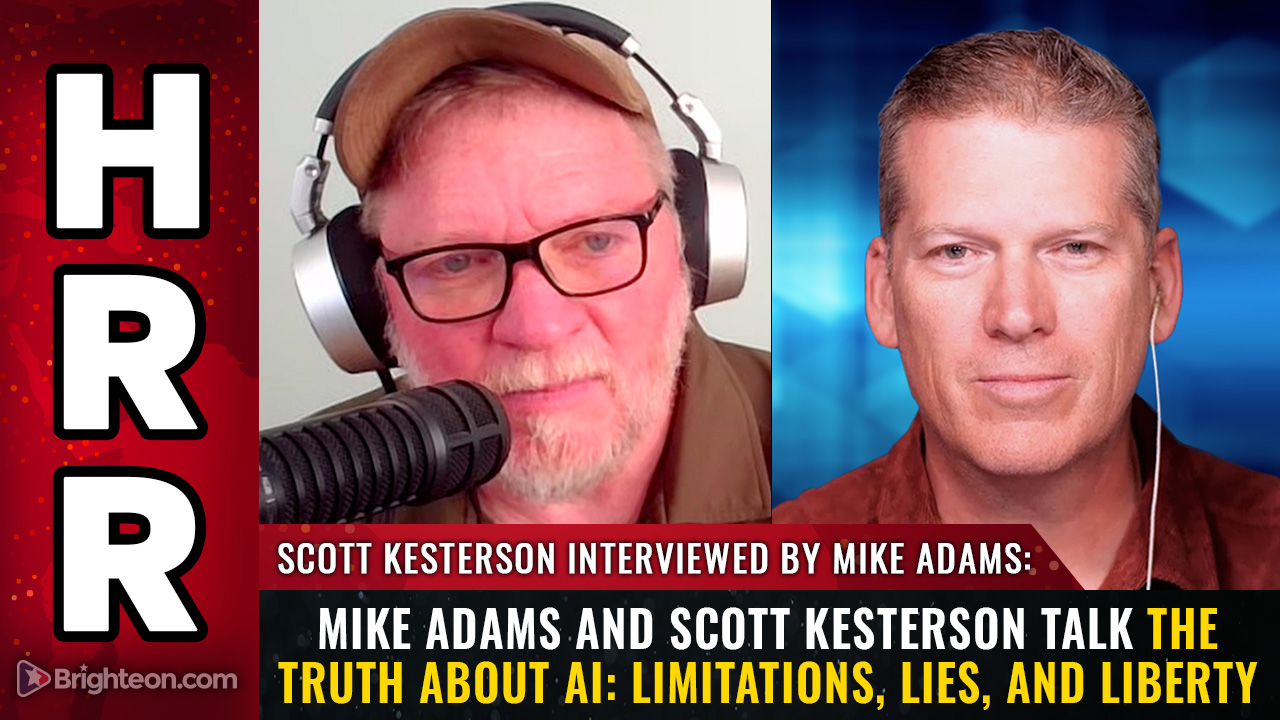How emotional unavailability is rewiring our relationships and what to do about it
08/21/2025 / By Lance D Johnson

You’re sitting across from someone you care about, the kind of person whose laugh used to make your chest warm, whose silence once felt like a comfortable pause in a favorite song. But now, the air between you is thick with something unspoken, a barrier neither of you seems to know how to dismantle. You’ve both mastered the art of small talk, the polite nods, the carefully curated texts that say just enough to keep the connection alive—but not so much that it risks real vulnerability and exposure. Sound familiar?
Emotional unavailability has become the default setting for millions of people. We’ve built fortresses around our hearts, mistaking armor for strength, and in the process, we’ve starved ourselves of the very thing we crave: genuine connection.
The more we protect ourselves from hurt, the more we ensure we’ll never feel the depth of love, trust, or intimacy we claim to want. But here’s the good news: emotional availability isn’t a fixed trait—it’s a skill. And like any skill, it can be learned, practiced, and mastered, even in the midst of deep seated trauma and a history of relationship fallout.
Key points:
- Emotional unavailability is a learned survival tactic, often rooted in past wounds, that sabotages present-day relationships by keeping love and vulnerability at arm’s length.
- The “energetic mirror” concept reveals that our external relationships reflect our internal state—what we resent in others often points to unmet needs within ourselves.
- Five transformative practices—mindful emotional processing, authentic self-expression, value alignment, feedback loops, and vulnerability—can rewire patterns of detachment.
- Cultural and gendered conditioning (e.g., men suppressing emotions, women over-accommodating) deepens the crisis, but intentional self-work can break the cycle.
- True intimacy requires risk, but the payoff—a life rich with meaning, trust, and unfiltered joy—far outweighs the fear of temporary discomfort.
The invisible walls we build
Emotional unavailability isn’t just about being “cold” or “distant.” It’s a spectrum of behaviors so normalized we often don’t recognize them: the partner who stonewalls during conflict; the friend who deflects deep questions with humor; the colleague who nods along in meetings but never shares a personal thought. These patterns aren’t flaws—they’re adaptations and strategies we adopted (often in childhood) to survive environments where vulnerability felt unsafe.
Consider the child who learned that love was conditional—only given when they performed well, stayed quiet, or mirrored a parent’s expectations. As adults, these individuals might unconsciously replicate the dynamic, equating self-worth with productivity or people-pleasing. Or take the person who, after a betrayal, swore they’d “never be fooled again,” only to find themselves years later in a relationship where they withhold trust like a scarce resource. These aren’t choices; they’re patterns of behavior.
Research in attachment theory confirms this. Studies show that infants who experience inconsistent care (a parent who is sometimes nurturing, sometimes dismissive) often develop anxious-avoidant attachment—a push-pull dynamic where they crave closeness but panic when it gets too real. As adults, they might pursue relationships only to sabotage them when intimacy deepens, or they might stay in emotionally barren partnerships because the alternative—being alone—feels even more terrifying.
The high cost of emotional lockdown
The consequences of chronic emotional unavailability aren’t just relational—they’re physiological. Studies link suppressed emotions to elevated cortisol levels, weakened immune function, and even shortened telomeres (the protective caps on our DNA strands, whose erosion is tied to aging). In other words, holding in your feelings doesn’t just hurt your heart; it ages your cells.
Then there’s the cultural dimension. Men, in particular, are socialized to equate vulnerability with weakness, a toxic coping mechanism. Women, meanwhile, are often conditioned to prioritize others’ comfort over their own authenticity, leading to a different kind of emotional unavailability: the kind where you’re present but not real. (Think of the mother who smiles through exhaustion or the employee who says “I’m fine” through gritted teeth.)
This isn’t just about romance. Friendships, workplaces, and even our relationship with ourselves suffer when we treat emotions like landmines to avoid. Ever left a conversation feeling hollow, like you’d just performed a script? That’s the toll of inauthenticity. Or worse: ever realized you don’t even know what you feel anymore, because you’ve spent so long translating your emotions into what’s “acceptable”? That’s the cost of disconnection.
Fifteen practices to dismantle the walls keeping you emotionally unavailable
Breaking free requires more than just “trying harder.” It demands rewiring the nervous system’s response to vulnerability—a process that, like physical therapy for an atrophied muscle, takes patience and repetition. Here’s how to start:
1. Turn the mirror inward:
Before you critique your partner’s emotional distance, ask: Where am I distant from myself? Journal prompts like “Where do I feel unseen in this relationship, and how does that reflect how I’ve abandoned parts of me?” can reveal blind spots. For example, if you resent a friend for being flaky, explore whether you’ve been flaking on your own creative dreams or self-care.
2. Feel it to heal it:
Emotions are energy in motion; when we suppress them, they don’t disappear—they metastasize. Try this: The next time you feel anger, sadness, or fear, pause and name the sensation physically (“My chest is tight,” “My hands are clammy”). Breathe into it for 90 seconds (the average time it takes for an emotional wave to crest and subside). This isn’t about “fixing” the feeling—it’s about proving to your nervous system that you can survive it.
3. Lead with your truth:
Intimacy isn’t built on grand gestures; it’s built in micro-moments of honesty. Start small: Tell a friend, “I’ve been feeling lonely lately, even though I don’t always show it.” Share with a partner, “I shut down during conflicts because I’m scared of being overwhelmed.” Authenticity is contagious—when you risk it, others often meet you there.
4. Audit your values:
Write down your top five relationship values (e.g., trust, adventure, intellectual stimulation). Now ask: Do my current relationships honor these, or am I tolerating less because I don’t believe I deserve more? Many of us accept crumbs because we’re still operating from the wounded child’s playbook. Rewrite the rules. If “respect” is a value but you stay with someone who belittles you, you’re not upholding your own standard.
5. Invite the hard conversations:
Feedback isn’t criticism—it’s data. Ask a trusted friend: “Where have you seen me hold back emotionally?” Or tell a partner: “I want to get better at sharing my needs. Can you help me by pointing out when I seem closed off?” This isn’t about self-flagellation; it’s about collaborative growth. When others see you working on yourself, they’re often inspired to do the same.
6. Reconnect with your own feelings first (the foundation)
You cannot share what you don’t have access to. Before focusing on empathy for others, focus on identifying your own emotions. Start simple.
How to practice: Set a timer for 2 minutes, 2-3 times a day. Ask yourself: “What am I feeling right now?” Don’t judge the answer. Use a “feelings wheel” (easily found online) to move from basic words (e.g., “bad”) to more precise ones (e.g., “apprehensive,” “disconnected”). Journal these observations without criticism.
7. Practice mindful presence
Trauma often pulls you into the past (rumination) or the future (anxiety). Empathy happens in the present moment. Mindfulness grounds you in the “now,” where connection occurs.
How to practice: Engage in a daily 5-minute mindfulness meditation, focusing solely on your breath. When with someone, consciously bring your attention to them: notice the sound of their voice, their body language, and the environment you’re both in. Gently pull your mind back when it wanders.
8. Develop a vocabulary for emotions
A limited emotional vocabulary is like being colorblind to feelings. Expanding your lexicon gives you the tools to identify subtler shades of emotion in yourself and others.
How to practice: Study a feelings wheel. When you read a book or watch a film, pause to name the emotions the characters are likely experiencing. Try to use one new “emotion word” each day to describe your own state.
9. Engage in active and reflective listening
Empathy is less about what you say and more about how well you listen. Most people listen to respond; your goal is to listen to understand.
How to practice: In conversations, focus entirely on the speaker. When they finish a thought, try reflecting back what you heard: “It sounds like you’re feeling really frustrated because…” or “So what I’m hearing is that was a really overwhelming experience for you.” This confirms their feeling is received.
10. Ask open-ended, emotion-focused questions
Shift conversations from transactional (“How was your day?” “Fine.”) to emotional and exploratory. This invites depth and shows you care about their internal world.
How to practice: Ask questions like: “What was the highlight of your week, and what made it so meaningful?” “How did that situation make you feel?” “What’s been on your mind lately?”
11. Consume emotionally rich art and stories
Art, literature, and film are safe simulators for empathy. They allow you to step into another person’s experience and feel with them from a distance, which can help reawaken your own emotional responses.
How to practice: Watch a character-driven film or read a novel with a complex protagonist. Afterward, journal or reflect on what the character felt, why they made certain choices, and what their deepest fears and desires were.
12. Practice radical self-compassion
You cannot extend genuine kindness to others if you are at war with yourself. The criticism you direct inward creates a barrier to connection outward. Healing your relationship with yourself is paramount.
How to practice: Talk to yourself as you would a dear friend who is struggling. When you make a mistake or feel numb, acknowledge it with kindness: “It’s understandable that I feel this way given what I’ve been through. I am doing my best.”
13. Start small and set micro-goals
You don’t need to become a master of empathy overnight. The pressure to “be different” can be paralyzing. Small, consistent efforts rewire neural pathways over time.
How to practice: Set a tiny, achievable goal for the day. “Today, I will ask one person how they are feeling and listen to their full answer.” Or, “I will identify three emotions I felt today.” Celebrate these small wins.
14. Re-engage with your body through somatic practices
Trauma and chronic stress live in the body, not just the mind. Reconnecting with physical sensations is a direct path to unlocking stored emotions.
How to practice: Yoga, tai chi, mindful walking, or even a simple body scan meditation can help. Notice where you hold tension (jaw, shoulders, gut) and breathe into those spaces. Emotions have physical components; learning to feel your body is learning to feel your emotions.
15. Consider professional guidance
The “dulling” of emotions is often a sophisticated protective strategy developed by your nervous system to survive overwhelming pain. A therapist, particularly one trained in trauma (e.g., Somatic Experiencing, EMDR, IFS, or Hakomi), can provide a safe container to gently explore and process this pain without being re-traumatized. They can offer tailored tools for your specific history.
Sources include:
Submit a correction >>
Tagged Under:
attachment theory, authentic living, co dependency, connection crisis, emotional freedom, emotional honesty, emotional intelligence, emotional labor, emotional suppression, fear of rejection, healing journey, intimacy building, mindfulness techniques, Personal Growth, psychological patterns, relationship repair, self worth, self-awareness, toxic masculinity, vulnerability practice
This article may contain statements that reflect the opinion of the author
RECENT NEWS & ARTICLES
COPYRIGHT © 2017 AWAKENING NEWS



















